
By MICHAEL M. DUGAN
Scenario: The tones go off at the Bensenville (IL) Fire Department (BFD) at 0615 hours for a fire in a three-story apartment. While units are en route, the Bensenville Police Department arrives on scene and confirms a working fire on the top floor. The building was built using ordinary construction in the 1970s, has 18 units, and features a wood-joist mansard roof.
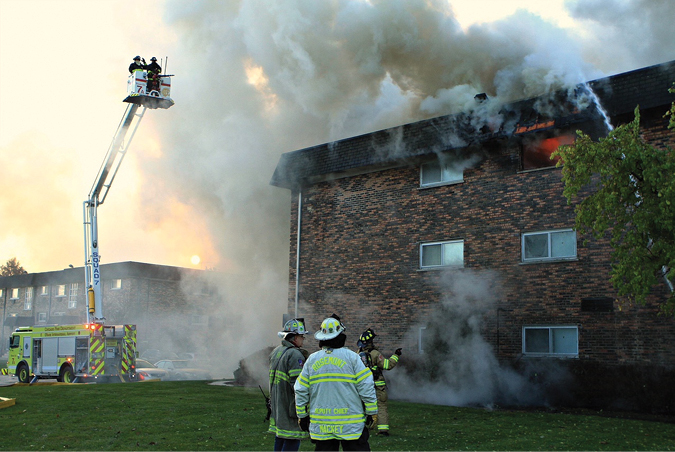
(1) Heavy fire can be seen in the top-floor unit of this three-story building. Because of the amount of fire burning in the unit and into the cockloft, defensive operations are being set up. (Photos by Tim Olk.)
Know Your Building and Area
Knowledge of your response area is critical. This building was in the flight path of O’Hare International Airport; therefore, when the building was renovated, triple-pane, thermal-glass windows were installed to deaden airplane noise. Fire showing out of triple-pane windows indicates there is a good-size fire in that fire compartment. The fire in this scenario was also impacting the top-floor hallway.
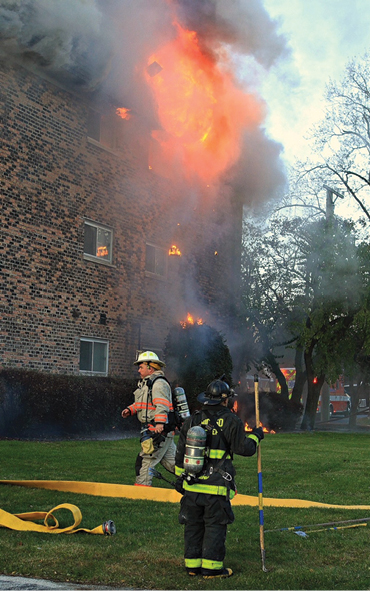
(2) Debris is on fire and falling from the roof overhang. Large-diameter hose is being moved to supply an elevated stream.
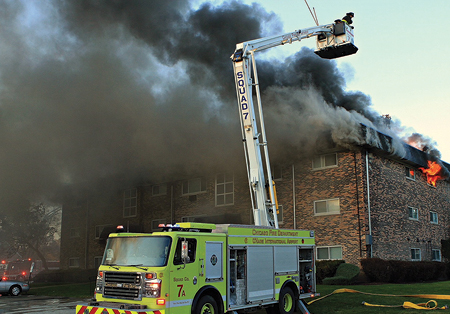
(3) Members of Squad 7 are awaiting water. We can see from the smoke that the fire now is spreading throughout the cockloft space.
The BFD had to search six apartments and locate the exact residence. If your crew is going to search inside a building with triple-pane windows, ensure that it has a secondary means of egress. Also, if a fire department member did not determine the type of windows being installed when the building was being renovated, you may not know before the incident that the windows were triple pane. This knowledge is essential to keep crews operating inside a building safe.

(4) The fire has control of the cockloft and is burning through the roof. We needed more tower ladders or elevated master streams at this fire.
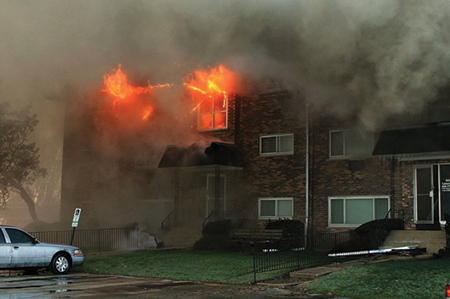
(5) The amount of visible fire here gives us an idea of how advanced this fire was on arrival. Forty-five minutes of headway plus a large amount of clutter made this a difficult fire.
Because of the building’s construction and the tightness of the area of the fire’s origin, the fire spread into the cockloft and involved the roofing material. In cases such as these, the conditions on arrival and the fire impingement and involvement of the attic will determine whether to commit resources to the roof area. In this incident, the condition of the roof was determined to be suspect, so members did not perform vertical roof ventilation.

(6) Squad 7 now has water and is starting to knock down the fire. Smoke conditions indicate that the fire has control of much of the top floor and the cockloft space.
Postfire Analysis
The BFD’s postfire analysis determined that the fire had been burning for approximately 45 minutes before the fire department was notified; this allowed it to gain significant headway. Because of the amount of fire and how the exterior defensive operation was set up, it was important to position the apparatus (the tower ladder/aerial) properly to cover the largest portion of the building. Also, it was important to have an engine company with a master stream nearby to get water to the involved area quickly. Always think ahead and try to determine your actions based on the conditions you observe.
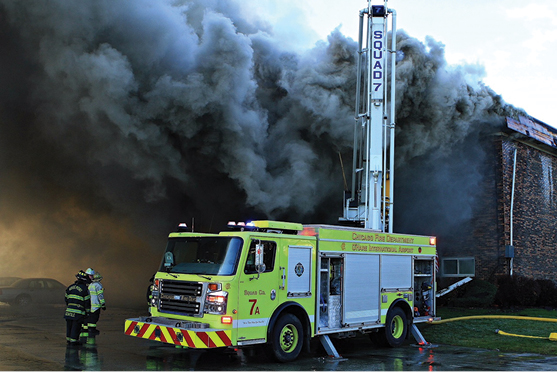
(7) The smoke conditions indicate that the fire has intensified. Members are setting up for an exterior attack and a prolonged operation.
Because there had been a previous fire in this unit, the BFD had knowledge of the individual living there. The occupant was a 64-year-old male who was a heavy smoker. Because of his chronic obstructive pulmonary disease, he was on oxygen but was still smoking. The BFD also knew he was a hoarder. He had a significant amount of clutter in his living space, adding to the fuel load. Unfortunately, he did not survive this fire. An autopsy showed that he had no soot in his lungs; therefore, it’s believed that he had a heart attack before the fire or as a result of starting the fire.
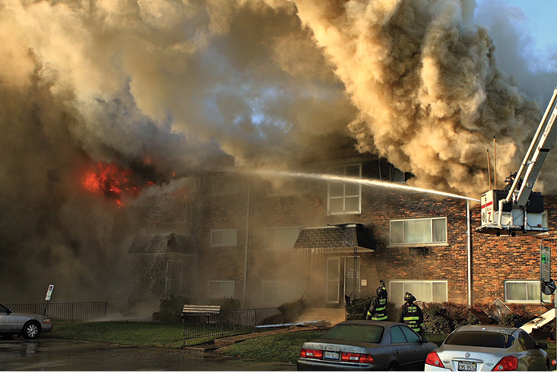
(8) The smoke is pushing from a remote apartment on the A/D corner of the building. More help and more master streams were needed to control the fire.
This fire showed that knowledge gained on runs, at drills, or while just out in the neighborhood paid immeasurable dividends. The BFD knew about the triple-pane windows and how they would impact fire operations. They also knew about the building’s construction, its roof from previous fires and drills, and the resident based on their past interactions with him.
The lesson learned from this fire is, “If you see something, say something!” Pass on the knowledge that you gained on this run, drill on similar circumstances, and then drive through the neighborhood. If you don’t share your knowledge and experience, no one will get better. However, if you share them, we will all get better.
MICHAEL M. DUGAN is a 42-year fire service veteran and a 31-year member of the Fire Department of New York (FDNY), where he served as captain of Ladder Company 123 in Crown Heights, Brooklyn. As a lieutenant, he served in Ladder Company 42 in the South Bronx. While assigned as a firefighter in Ladder Company 43, in Spanish Harlem, he received the James Gordon Bennett Medal in 1992 and the Harry M. Archer Medal in 1993, FDNY’s highest award for bravery. He was a volunteer firefighter in Halesite, New York. He lectures on truck company operations, building construction, size-up, and today’s fire service.

